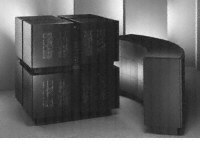|
|


|
|
Components
David Miller of AT&T Bell Labs patented the optical transistor, a component
central to digital optical computing. Called Self-ElectroOptic-Effect Device,
or SEED, the transistor involved a light-sensitive switch built with layers of
gallium arsenide and gallium aluminum arsenide. Beams of light triggered
electronic events that caused the light either to be transmitted or absorbed,
thus turning the switch on or off.
Within a decade, research on the optical transistor led to successful work on
the first all-optical processor and the first general-purpose all-optical
computer. Bell Labs researchers first demonstrated the processor there in
1990. A computer using the SEED also contained lasers, lenses, and fast light
switches, but it still required programming by a separate, non-optical
computer. In 1993, researchers at the University of Colorado unveiled the
first all-optical computer capable of being programmed and of manipulating
instructions internally.

|
|
|
 Connection Machine
Connection Machine
|
|
Computers
Daniel Hillis of Thinking Machines Corp. moved artificial intelligence a step
forward when he developed the controversial concept of massive parallelism in
the Connection Machine. The machine used 16,000 processors and could complete
several billion operations per second. Each processor had its own small memory
linked with others through a flexible network that users could alter by
reprogramming rather than rewiring.
The machine's system of connections and switches let processors broadcast
information and requests for help to other processors in a simulation of
brainlike associative recall. Using this system, the machine could work faster
than any other at the time on a problem that could be parceled out among the
many processors.

|
|
|
|
|
Computers
IBM and MIPS released the first RISC-based workstations, the PC/RT and
R2000-based systems. Reduced instruction set computers grew out of the
observation that the simplest 20 percent of a computer's instruction set does
80 percent of the work, including most base operations such as add, load from
memory, and store in memory.
The IBM PC-RT had 1 megabyte of RAM, a 1.2-megabyte floppy disk drive, and a
40-megabyte hard drive. It performed 2 million instructions per second, but
other RISC-based computers worked significantly faster.

|
|
|
 Compaq
Compaq
|
|
Components
Compaq beat IBM to the market when it announced the Deskpro 386, the first
computer on the market to use Intel's new 80386 chip, a 32-bit microprocessor
with 275,000 transistors on each chip. At 4 million operations per second and
4 kilobytes of memory, the 80386 gave PCs as much speed and power as older
mainframes and minicomputers.
The 386 chip brought with it the introduction of a 32-bit architecture, a
significant improvement over the 16-bit architecture of previous
microprocessors. It had two operating modes, one that mirrored the segmented
memory of older x86 chips, allowing full backward compatibility, and one that
took full advantage of its more advanced technology. The new chip made
graphical operating environments for IBM PC and PC-compatible computers
practical. The architecture that allowed Windows and IBM OS/2 has remained in
subsequent chips.

|

|
|

|
|
